Wildflowers, Grasses and Other Nonwoody Plants
Media
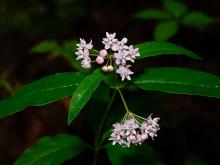
Species Types
Scientific Name
Asclepias quadrifolia
Description
One of our earliest blooming milkweeds, fourleaf milkweed bears round clusters of pink or cream-colored flowers. As the common names suggest, at least some of the leaves are arranged in whorls of 4.
Media
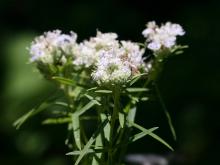
Species Types
Scientific Name
Pycnanthemum tenuifolium
Description
Slender mountain mint has smooth, square stems, opposite, narrow leaves, and dense heads of 2-lipped white (or lavender) flowers. Aromatic and minty, it can be grown at home in the herb garden, and its leaves used for seasoning food.
Media
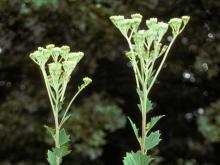
Species Types
Scientific Name
Arnoglossum atriplicifolium (also Cacalia atriplicifolia)
Description
The stout, smooth leaves of pale Indian plantain, with their glaucous-white coating beneath, look almost artificial. They are irregularly shaped, with pointed lobes. At the base of the plant, they can be 6 inches wide. They become gradually smaller up the stem.
Media
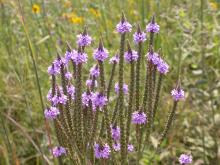
Species Types
Scientific Name
Verbena hastata
Description
Blue vervain is a tall, slender, erect perennial with branching stems and rough hairs. Its tubular flowers are clustered in many terminal spikes, and can be deep purple, violet, light lavender, or rarely white.
Media

Species Types
Scientific Name
Teucrium canadense
Description
Like most other mints, American germander has square stems, opposite leaves, and two-lobed flowers. The unusual configuration of the corolla lobes is the key identifying characteristic.
Media

Species Types
Scientific Name
Helianthus annuus
Description
Whether you see the wild form or any of the many cultivated varieties, this poster child of the sunflower family cultivates its own sunny impression. Common sunflower is also the state flower of Kansas.
Media

Species Types
Scientific Name
Echinacea paradoxa
Description
Yellow coneflower is the only coneflower with yellow ray flowers, not pink or purplish ones, which explains the species name, paradoxa. Although cultivated statewide, this prairie and glade wildflower grows natively only in the Ozarks.
Media
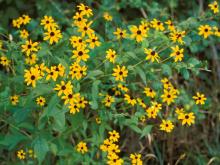
Species Types
Scientific Name
Rudbeckia triloba
Description
Brown-eyed Susan is a bushy perennial with much-branching stems and plenty of flowerheads. Compared to Missouri’s other Rudbeckia species, its flowerheads are the smallest, growing to only about one inch across.
Media
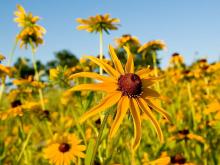
Species Types
Scientific Name
Rudbeckia hirta
Description
Black-eyed Susan is a tremendously popular native wildflower for gardening. It’s also commonly planted along roadways, so when it’s blooming, May through October, you’re sure to see it somewhere.
Media

Species Types
Scientific Name
Ratibida pinnata
Description
The “disk” of gray-headed coneflower is an inch-long, round knob. It starts off gray, but as the disk florets open and bloom, it turns brown. It grows almost statewide in prairies, glades, pastures, fencerows, and roadsides.
See Also
About Wildflowers, Grasses and Other Nonwoody Plants in Missouri
A very simple way of thinking about the green world is to divide the vascular plants into two groups: woody and nonwoody (or herbaceous). But this is an artificial division; many plant families include some species that are woody and some that are not. The diversity of nonwoody vascular plants is staggering! Think of all the ferns, grasses, sedges, lilies, peas, sunflowers, nightshades, milkweeds, mustards, mints, and mallows — weeds and wildflowers — and many more!





















